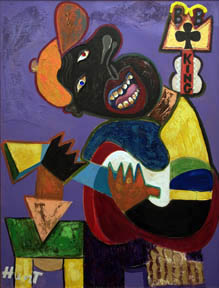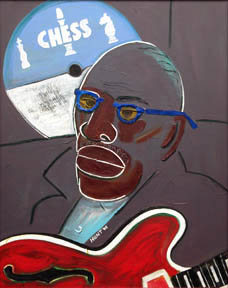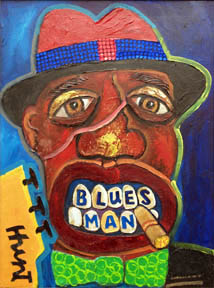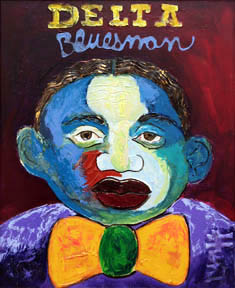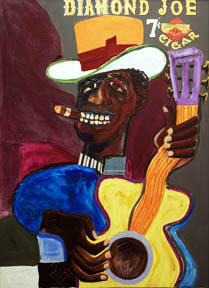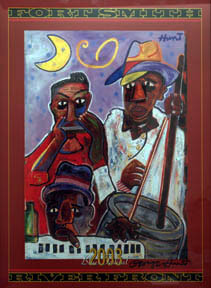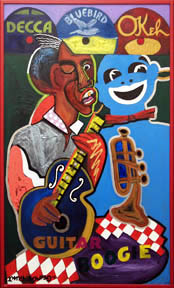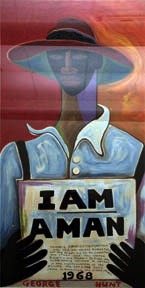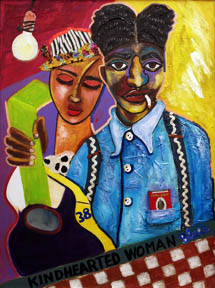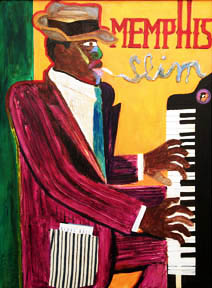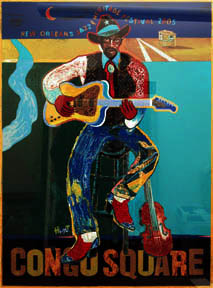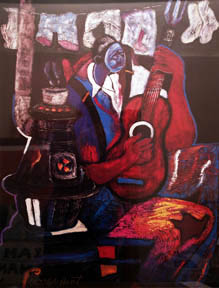George Hunt
George Hunt is an artist with a gift for seeing things differently than most people.

Born in 1940 in rural Lake Charles, Louisiana, George was delivered into the world in a sugarcane field by the hands of his great-grandmother. His single mother, grandmother, and great-grandmother reared him.
Hunt's formal education came from the University of Arkansas at Pine Bluff, where he received a BA degree in 1960. He did postgraduate studies at the University of Memphis and at New York University. In the early sixties he studied under Hale Woodruff. Mr. Hunt spent three decades teaching art education and coaching at George Washington Carver High School in Memphis before turning full time to painting. He now works in a studio overlooking world-famous Beale Street.
George Hunt's personal "stamp" on the cubism style of painting includes collage, vibrant colors, and lively texture. The bold colors are reminiscent of his childhood experiences of going to church and seeing women wearing very colorful hats. Today much of Hunt's work is influenced by African American experiences in the South. "I've always liked Picasso's work," says George Hunt. He also learned a lot from artist such as Romare Bearden, Charles Alston, and Modigliani. The person who he feels had the most impact on his work, although informally, was Dewitt Jordan.
In addition to large doses of indigenous music, one of the things he saw in the South was the civil rights movement and that experience became a painting in 1997, which in turn, became a US Postage Stamp issued in 2005 as part of the United States Postal Service series, "To Form A More Perfect Nation."
George Hunt was honored for his painting, "America Cares / Little Rock Nine" at ceremonies in Little Rock and Memphis. The painting was originally commissioned for the Central High School Museum, but first spent five years hanging in the White House in Washington, D.C. First Lady Hillary Clinton, in a personal note to Mr. Hunt, wrote, "we are grateful that our visitors and staff have such a powerful image of hope and freedom to greet, inspire and inform them."
In 2002, the U.S. Congress brought attention to America's indigenous music by officially declaring 2003 as the "Year of the Blues." George Hunt was named the Official Artist for the "Year of the Blues," and he created a new body of work for a national tour. The exhibit, "Conjurating the Blues, The High Cotton Tour," consisted of 26 large paintings that depicted the history of blues music in America. The title painting proudly hung in the grand lobby of Radio City Music Hall in New York during the opening tribute show for the Year of the Blues as Martin Scorcese filmed the documentary movie, "Lightnin' in a Bottle." The exhibit continued on to Seattle at Experience Music Project, Chicago, Memphis, Helena, AR (King Biscuit Festival) and Clarksdale, MS (Delta Blues Museum.)
Other notable awards and honors include being named the Rock & Roll Hall of Fame Museum's American Music Master's featured artist in 1998 and again in 2000, creating the Blues Foundation poster art commemorating the 25th annual Handy Awards in 2004, creating the New Orleans Jazz and Heritage Festival Congo Square Heritage poster art in 2005, and creating the original blues image for the Memphis In May Beale Street Music Festival poster every year since 1994.
Ninety-nine percent of what George Hunt paints come from the Southern African-American experience, especially the folk tradition, civil rights movement, the mythic heroism of Black manhood, and of course blues music and culture. His mother-in-law owned a jukejoint in Helena, Arkansas called the Dreamland Cafe. There, George Hunt listened to blues legends like Sonny Boy Williamson and watched the patrons dance, drink, eat catfish, court, sport and score. The visions for George Hunt's art have been steeped in the music and life passages of blues people.
(Click thumbnail image to enlarge.)
